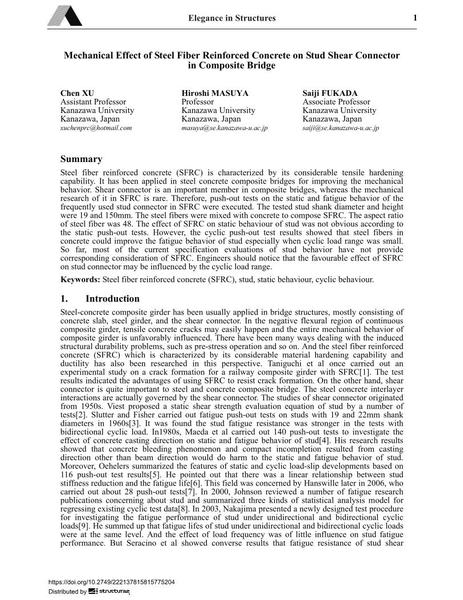Mechanical Effect of Steel Fiber Reinforced Concrete on Stud Shear Connector in Composite Bridge

|
|
|||||||||||
Bibliographic Details
| Author(s): |
Chen Xu
Hiroshi Masuya Saiji Fukada |
||||
|---|---|---|---|---|---|
| Medium: | conference paper | ||||
| Language(s): | English | ||||
| Conference: | IABSE Conference: Elegance in structures, Nara, Japan, 13-15 May 2015 | ||||
| Published in: | IABSE Conference Nara 2015 | ||||
|
|||||
| Page(s): | 334-335 | ||||
| Total no. of pages: | 8 | ||||
| Year: | 2015 | ||||
| DOI: | 10.2749/222137815815775204 | ||||
| Abstract: |
Steel fiber reinforced concrete (SFRC) is characterized by its considerable tensile hardening capability. It has been applied in steel concrete composite bridges for improving the mechanical behavior. Shear connector is an important member in composite bridges, whereas the mechanical research of it in SFRC is rare. Therefore, push-out tests on the static and fatigue behavior of the frequently used stud connector in SFRC were executed. The tested stud shank diameter and height were 19 and 150mm. The steel fibers were mixed with concrete to compose SFRC. The aspect ratio of steel fiber was 48. The effect of SFRC on static behaviour of stud was not obvious according to the static push-out tests. However, the cyclic push-out test results showed that steel fibers in concrete could improve the fatigue behavior of stud especially when cyclic load range was small. So far, most of the current specification evaluations of stud behavior have not provide corresponding consideration of SFRC. Engineers should notice that the favourable effect of SFRC on stud connector may be influenced by the cyclic load range. |
||||
| Keywords: |
cyclic behaviour static behaviour stud Steel fiber reinforced concrete (SFRC)
|
||||
